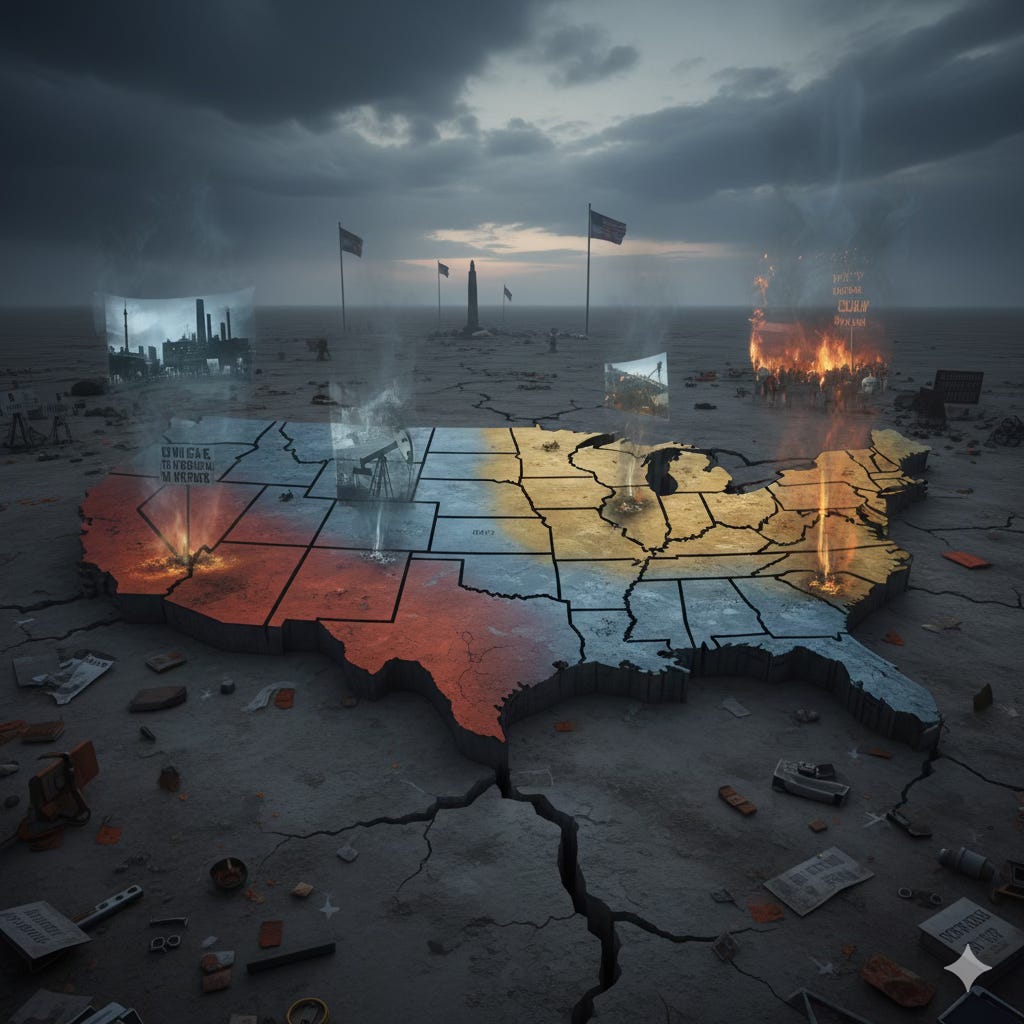This represents one potential trajectory for America’s future, a scenario made considerably more probable if Trump’s influence extends into an unprecedented third term. It’s worth examining how such a dissolution could unfold, not through dramatic collapse, but through incremental fracturing that becomes irreversible.
The Mechanics of Gradual Dissolution
Picture 2051. The United States exists only as a historical entity, studied the way we now examine the Austro-Hungarian Empire or Yugoslavia. There was no civil war, no foreign invasion, no single catastrophic moment marking the end. Instead, what occurred was a slow unraveling that became impossible to ignore, though by the time it was obvious, reversal was no longer possible.
The Constitutional Crisis of 2028 would serve as the initial fracture point. Imagine seven states refusing to certify federal election results, not as protest but as genuine rejection of federal authority. At that moment, the concept of a united country would transition from reality to comfortable fiction. This wouldn’t be sedition in the traditional sense, but rather states concluding that national unity no longer served their interests.
The federal debt default of 2031 would shatter the dollar’s global reserve currency status. This wouldn’t be theoretical economics affecting distant markets; this would mean your savings, your mortgage, your entire economic reality fundamentally restructured overnight. International confidence in American institutions would evaporate, and with it, the economic glue holding disparate regions together.
The Water Wars and Resource Fragmentation
By 2035, water wars would erupt across the Southwest. This isn’t science fiction; it’s extrapolation from current trends. Southwestern states would break federal water-sharing agreements because survival would outweigh union. When your cities are running dry and the federal government seems incapable of addressing the crisis, adherence to distant authority becomes abstract while thirst is immediate.
Regional Realignment
The West Coast would separate first, forming a digital republic economically bound to Asian markets. California’s economy alone already rivals entire nations; add Washington and Oregon, and you have a region with more in common with Seoul and Tokyo than with Tennessee. Their separation wouldn’t be hostile secession but pragmatic realignment.
The Southern coalition would assemble around Texas, creating a nation of faith, oil, and heavily defended borders. Their legal codes would cite scripture where federal precedents once stood. This region would see itself not as breaking away but as preserving authentic American values that the rest of the country abandoned.
The Atlantic Union would form from the Northeast, essentially becoming a banking federation more connected to European financial systems than to the American interior. Their aging, educated population would embrace technological efficiency over democratic process. Liberty would be redefined as competent management rather than popular sovereignty.
The Forgotten Middle
The Midwest would fragment into isolated territories. Some would thrive as agricultural city-states, controlling food production and therefore wielding significant power. Others would collapse as water grows scarce and young people flee. Suburbs would become fortified communities, and highways would transform into trade routes with checkpoint tolls. The breadbasket would become a patchwork of competing interests.
The Normalized Transition
The most chilling aspect would be how normal each step would feel. Interstate travel would require enhanced identification starting around 2033. Regional currencies would appear as “temporary measures” to address federal monetary instability. By 2037, school districts would redraw maps, teaching regional history rather than national narrative. Family reunions would become international events requiring passports and currency exchange.
By 2045, “America” would become a historical term, the way “Christendom” or “the Ottoman Empire” are historical concepts rather than political realities. By 2049, regions would fight over custody of founding documents. The Constitution and Declaration of Independence would rotate between regional capitals as relics of a fallen civilization, the way European museums trade antiquities.
Washington as Museum
Washington, D.C. would stand as a neutral museum district, the National Mall transformed into a memorial park for a nation that once was. Tourists from the successor states would visit the way Europeans tour Roman ruins, marveling that such unity once existed.
Historical Parallels
The most striking aspect would be how normal it all felt while happening. Each step would seem reasonable in isolation. Each region’s complaints would have justification. By the time official maps were redrawn, citizens would have already accepted the new reality in their daily lives.
Rome didn’t fall in a day. The Soviet Union’s collapse seemed sudden but resulted from decades of accumulated dysfunction. America’s dissolution would follow this pattern: a continental nation disappearing while everyone watched, yet few truly comprehended what was happening until it had already occurred.
The Quiet End
The dissolution wouldn’t be marked by a final battle or formal surrender ceremony. It would end with a quiet, almost embarrassed admission that America had already been gone for years. The flag would still fly at government buildings. The national anthem would still play at sporting events. The Pledge of Allegiance would still be recited in some schools. But the nation these symbols represented would have vanished, not destroyed by external enemies but dissolved by its own citizens who stopped believing they were one people with shared destiny.
This scenario isn’t prediction; it’s projection. It illustrates how Trump’s continued dominance, his erosion of institutional norms, his encouragement of regional grievances, and his dismantling of shared national narrative could accelerate fractures that already exist. The question isn’t whether America could dissolve this way, but whether enough Americans recognize the danger in time to prevent it.




This century will be a bloodbath.
Our planet is stressed beyond endurance.
I adhere to the Gaia Principle and other extensions of shamanic intelligence. This is my belief, and that’s all it is: My Belief. I find it impossible to live in an unconscious reality. Everything is alive, all around us, all the time.
The universe knows what we are, even when we don’t know. Too many people live on this planet, choking it with the ash of man made volcanoes. Our fate approaches; it will be dark before its transformation. Billions will die in the next century. Earthquake, flood, all kinds of disasters are already triggered by the greed of industry and the complacent raping of forests and farms. I am afraid. I’m not afraid for myself. I’m old, I’ve lived my life. What about my kids, my grandkids? They will suffer and adapt or they will be swept away. I hope they will adapt and survive. As the Great Dying unravels across the planet, conditions will change quickly. Already the pace of change makes me dizzy. I feel the misery of the Turkish earthquake, the misery of hapless Syrians who did nothing but oppose a tyrant and lose their rebellion. Occasionally people die in huge numbers. Wars cause death on massive scales. We are seeing these wars arise from the minds of ignorant men who think they can dominate by force. The bloodbath is upon us and it will only intensify in the coming years. It is with deep sorrow that I say this, but there is no forestalling the karmic scythe that is beginning to mow us down and expunge our social structures.
Let's hope it doesn't come to this, but under the present circumstances, it would be a bad idea. It would be intersting to see who the tech-bros align themselves with.